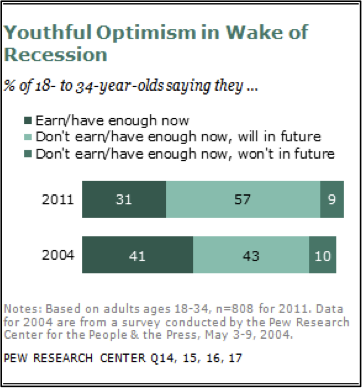You have /5 articles left.
Sign up for a free account or log in.
The PEW Research Center published a report on February 9th entitled, “Young, Underemployed and Optimistic.” I was intrigued. First, the study confirmed that it’s a harsh reality for 18-24 year olds:
- Young people face historic employment challenges. “…since 2010, the share of young adults ages 18-24 currently employed (54%) has been its lowest since the government began collecting these data in 1948.” And the fact that more young people are in school than ever before does not account for this significant low. (PEW, pages 1-3)
- Young people are getting the worst of the bad economy. “…the gap in employment between the young and all working-age adults – roughly 15 percentage points – is the widest in recorded history.” (PEW, pg 1)
- Young people’s pay has dropped more than other cohorts. “…young adults employed full time have experienced a greater drop in weekly earnings (down 6%) than any other age group over the past four years.” (PEW, pg 1)
Despite these realities, young people retained their pre-recession 2004 optimism levels; and the levels are surprisingly high. As seen in the chart below, 88% of 18-34 year olds are optimistic: 31% reported they earn enough money now to live they life they want, and 57% say they think they will in the future. Read more here.

Typical, naïve young people? Maybe. But as the recession has driven students back to school in droves, we in higher education have the opportunity to reinforce this optimism and give them a foundation for success. One way to perpetuate their enthusiasm could be to offer programs with “room.” Give them at least some time to explore their true interests, regardless of their ‘practical application.’
Steve Jobs gave us at least one example of how powerful this can be. In his 2005 Stanford commencement speech he told the story of how a calligraphy class, with no hint of practicality, led to developing aspects of the Mac years later.
He said, “None of this had even a hope of any practical application in my life. But ten years later, when we were designing the first Macintosh computer, it all came back to me. And we designed it all into the Mac. It was the first computer with beautiful typography. If I had never dropped in on that single course in college, the Mac would have never had multiple typefaces or proportionally spaced fonts. And since Windows just copied the Mac, it’s likely that no personal computer would have them.” Here’s the full transcript and video.
In the midst of unemployment increases, skyrocketing loans and budget cuts, there is more demand for classes and programs with practical application. By providing students with broad-spectrum academic choices and allowing space to pursue academic interests beyond their required classes, they will ultimately have more options and tools to pursue successful careers.
As confounding as it might seem, the study’s finding that the youngest generation feels confident about the future is a ray of hope.
What else can higher education do to perpetuate this positivity?





